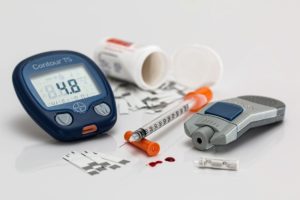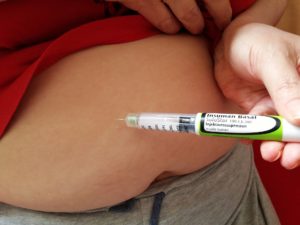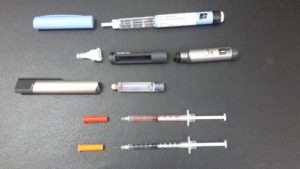- +91 87790 01598
- healthcentred@gmail.com
- Mon - Fri: 10.00 – 13.00 / Closed on Weekends
Home » Type 1 Diabetes
Type 1 Diabetes Mellitus is all about the absence of a vital hormone INSULIN. Though type I diabetes and type 2 diabetes have the same names with different numbers, they are not the same disease. The major difference being that type 2 is a lifestyle disease and in few cases reversible, type 1 is not. They do share similar outcomes when blood sugar is not in control which includes complications of eye, kidney, brain, nerves, stroke, heart disease, obstruction of blood vessels, secondary sexual dysfunction and the big difference is summed up to a single word i.e. INSULIN.
 What difference does insulin make to our body?
What difference does insulin make to our body?
The presence of this hormone is valued when it goes absent from the body. Like the human body is nothing without oxygen, similarly, the food we eat is nothing without insulin. Food glucose cannot get metabolized in the body without Insulin.
For example, the Role of insulin is like your hands while eating food, insulin feeds the cells of the body in the same way. Just like it would be very difficult to eat without hands, similarly without these hands (insulin) body cells will starve and die.
Along with helping glucose enter the cells, insulin is needed for fat and muscle building. This builder hormone stimulates the growth and development of these issues.
Where is insulin made in the body?
Situated behind the abdominal cavity in the stomach and part of the digestive and endocrine gland, the pancreas produces insulin. The pancreas contains 3 million clusters of cells which are divided into 4 types or categories. Out of these 4 types, Beta cells produce insulin
What happened when insulin-producing beta cells are damaged?
When beta cells are stimulated they release insulin, when bodies own immune system mistakenly destroys the beta cells, insulin production also reduced with this. When beta cells are destroyed due to autoimmunity insulin production comes to an abrupt halt leading to type 1 diabetes. This can strike children’s and adult at any age.
 Understanding type 1 diabetes
Understanding type 1 diabetes
Type 1 diabetes mellitus is an autoimmune disease. Bodies own immunity protects us from viruses and bacteria. In autoimmunity, the body destroys its own cells by mistake.
According to the American Diabetes Association, diabetes can be diagnosed through any one of the following tests:
1. A glycated haemoglobin test, which is commonly referred to as an HbA1c, or simply A1c, test. This test measures the body’s average blood sugar levels from the past 3 months. An A1c of 6.5% or higher is considered a diagnosis of diabetes, 5.7% to 6.4% is considered prediabetes, and an A1c of under 5.7% is considered normal.
2. A fasting plasma glucose (FPG) test, which measures the body’s glucose level after fasting (no caloric intake) for eight hours. An FPG result of 126 mg/dl or greater indicates a positive diagnosis of diabetes.
3. An oral glucose tolerance test (OGTT), which measures the body’s blood glucose level two hours after the intake of 75-grams of glucose. An OGTT result of 200 mg/dl or greater indicates a positive diagnosis of diabetes.
4. In someone with classic symptoms of hyperglycemia (high blood sugar), a random plasma glucose test with a result of 200 mg/dl or greater indicates a positive diagnosis of diabetes.
*Note, it is possible to get a diabetes-related antibody test (GAD antibodies, Anti Insulin AB, Anti Islet Cell Antibody, Low C peptide levels) to confirm a diagnosis of type 1 diabetes specifically (and not another kind of diabetes).
Symptoms of diabetes mellitus type 1?
● Weight loss
● Excessive thirst, frequent urination, sweating, weakness, fatigue, constant and recurrent infections, tingling sensation in feet, numbness, blurred vision, slow healing of injuries.
Treatment
Since the body has stopped producing insulin, the only way of survival is to provide the body with insulin. In type 1 diabetes insulin is a lifesaver and not a life sentence. There is no alternative to this treatment. If insulin is not given in time, then the child can die.
Along with insulin, a healthy lifestyle has to be maintained always. In growing years if care is not taken and the child puts on excess weight and fat, he may fall into trap of insulin resistance and be diagnosed with type 2 diabetes along with type 1 and diabetes complications become worse.

*As mentioned earlier insulin helps in carrying food to the cell and cells, in turn, produces energy. without insulin blood, glucose cannot enter the cell and builds up in the blood and cells are remained starved. this is known as high blood sugar or hyperglycemia. since the glucose of the food cannot be utilized cells will begin to use fat, the energy reserve of our body. when fat becomes a source of energy body produces ketones (chemicals produced in urine). The build-up of ketone in the body for too long can lead to serious illness and coma.
In a normal individual’s glucose from the food enters the cells with the help of insulin. In the cell, glucose is converted to energy. Once the energy needs of the cells are fulfilled, extra glucose is stored in liver muscles. When this is also filled excess glucose is stored as fat. Our body has an enormous capacity to store fat. When the body experiences a complete lack of insulin, like in people with type 1 diabetes, glucose cannot enter the cells and generate energy. despite the plenty amount of glucose molecules available in blood insulin-requiring cell behave as if there is no glucose. the body as part of the natural mechanism begins to break down fat and muscle into glucose for these cells, this leads to the increased amount of glucose in these cells. this leads to an increased amount of glucose in the blood. if that isn’t reversed person becomes sick with diabetes ketoacidosis.
© 2024 All rights reserved
Design By Global Technology